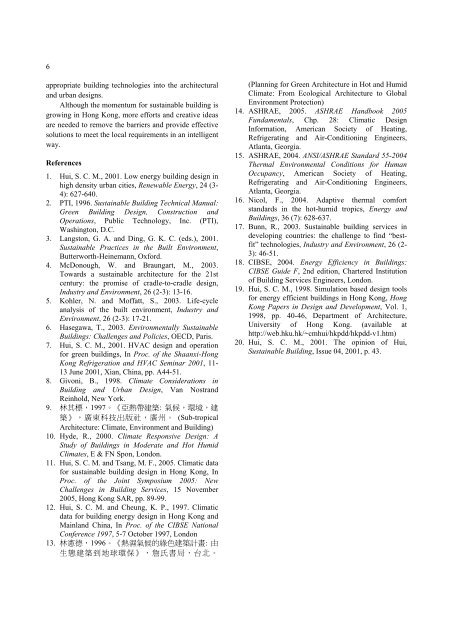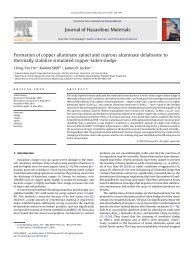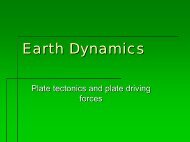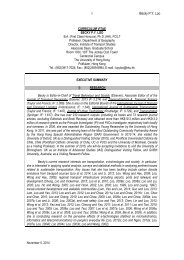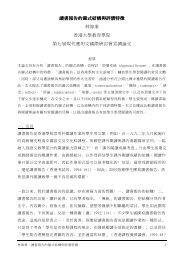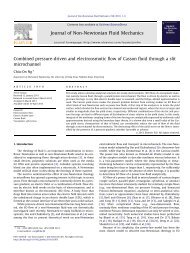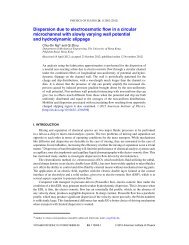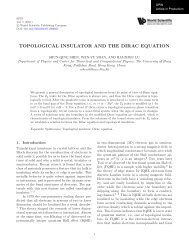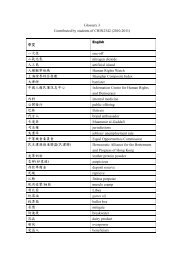sustainable building technologies for hot and humid climates
sustainable building technologies for hot and humid climates
sustainable building technologies for hot and humid climates
You also want an ePaper? Increase the reach of your titles
YUMPU automatically turns print PDFs into web optimized ePapers that Google loves.
6<br />
appropriate <strong>building</strong> <strong>technologies</strong> into the architectural<br />
<strong>and</strong> urban designs.<br />
Although the momentum <strong>for</strong> <strong>sustainable</strong> <strong>building</strong> is<br />
growing in Hong Kong, more ef<strong>for</strong>ts <strong>and</strong> creative ideas<br />
are needed to remove the barriers <strong>and</strong> provide effective<br />
solutions to meet the local requirements in an intelligent<br />
way.<br />
References<br />
1. Hui, S. C. M., 2001. Low energy <strong>building</strong> design in<br />
high density urban cities, Renewable Energy, 24 (3-<br />
4): 627-640.<br />
2. PTI, 1996. Sustainable Building Technical Manual:<br />
Green Building Design, Construction <strong>and</strong><br />
Operations, Public Technology, Inc. (PTI),<br />
Washington, D.C.<br />
3. Langston, G. A. <strong>and</strong> Ding, G. K. C. (eds.), 2001.<br />
Sustainable Practices in the Built Environment,<br />
Butterworth-Heinemann, Ox<strong>for</strong>d.<br />
4. McDonough, W. <strong>and</strong> Braungart, M., 2003.<br />
Towards a <strong>sustainable</strong> architecture <strong>for</strong> the 21st<br />
century: the promise of cradle-to-cradle design,<br />
Industry <strong>and</strong> Environment, 26 (2-3): 13-16.<br />
5. Kohler, N. <strong>and</strong> Moffatt, S., 2003. Life-cycle<br />
analysis of the built environment, Industry <strong>and</strong><br />
Environment, 26 (2-3): 17-21.<br />
6. Hasegawa, T., 2003. Environmentally Sustainable<br />
Buildings: Challenges <strong>and</strong> Policies, OECD, Paris.<br />
7. Hui, S. C. M., 2001. HVAC design <strong>and</strong> operation<br />
<strong>for</strong> green <strong>building</strong>s, In Proc. of the Shaanxi-Hong<br />
Kong Refrigeration <strong>and</strong> HVAC Seminar 2001, 11-<br />
13 June 2001, Xian, China, pp. A44-51.<br />
8. Givoni, B., 1998. Climate Considerations in<br />
Building <strong>and</strong> Urban Design, Van Nostr<strong>and</strong><br />
Reinhold, New York.<br />
9. 林 其 標 ,1997。《 亞 熱 帶 建 築 : 氣 候 , 環 境 , 建<br />
築 》, 廣 東 科 技 出 版 社 , 廣 州 。 (Sub-tropical<br />
Architecture: Climate, Environment <strong>and</strong> Building)<br />
10. Hyde, R., 2000. Climate Responsive Design: A<br />
Study of Buildings in Moderate <strong>and</strong> Hot Humid<br />
Climates, E & FN Spon, London.<br />
11. Hui, S. C. M. <strong>and</strong> Tsang, M. F., 2005. Climatic data<br />
<strong>for</strong> <strong>sustainable</strong> <strong>building</strong> design in Hong Kong, In<br />
Proc. of the Joint Symposium 2005: New<br />
Challenges in Building Services, 15 November<br />
2005, Hong Kong SAR, pp. 89-99.<br />
12. Hui, S. C. M. <strong>and</strong> Cheung, K. P., 1997. Climatic<br />
data <strong>for</strong> <strong>building</strong> energy design in Hong Kong <strong>and</strong><br />
Mainl<strong>and</strong> China, In Proc. of the CIBSE National<br />
Conference 1997, 5-7 October 1997, London<br />
13. 林 憲 德 ,1996。《 熱 濕 氣 候 的 綠 色 建 築 計 畫 : 由<br />
生 態 建 築 到 地 球 環 保 》, 詹 氏 書 局 , 台 北 。<br />
(Planning <strong>for</strong> Green Architecture in Hot <strong>and</strong> Humid<br />
Climate: From Ecological Architecture to Global<br />
Environment Protection)<br />
14. ASHRAE, 2005. ASHRAE H<strong>and</strong>book 2005<br />
Fundamentals, Chp. 28: Climatic Design<br />
In<strong>for</strong>mation, American Society of Heating,<br />
Refrigerating <strong>and</strong> Air-Conditioning Engineers,<br />
Atlanta, Georgia.<br />
15. ASHRAE, 2004. ANSI/ASHRAE St<strong>and</strong>ard 55-2004<br />
Thermal Environmental Conditions <strong>for</strong> Human<br />
Occupancy, American Society of Heating,<br />
Refrigerating <strong>and</strong> Air-Conditioning Engineers,<br />
Atlanta, Georgia.<br />
16. Nicol, F., 2004. Adaptive thermal com<strong>for</strong>t<br />
st<strong>and</strong>ards in the <strong>hot</strong>-<strong>humid</strong> tropics, Energy <strong>and</strong><br />
Buildings, 36 (7): 628-637.<br />
17. Bunn, R., 2003. Sustainable <strong>building</strong> services in<br />
developing countries: the challenge to find “bestfit”<br />
<strong>technologies</strong>, Industry <strong>and</strong> Environment, 26 (2-<br />
3): 46-51.<br />
18. CIBSE, 2004. Energy Efficiency in Buildings:<br />
CIBSE Guide F, 2nd edition, Chartered Institution<br />
of Building Services Engineers, London.<br />
19. Hui, S. C. M., 1998. Simulation based design tools<br />
<strong>for</strong> energy efficient <strong>building</strong>s in Hong Kong, Hong<br />
Kong Papers in Design <strong>and</strong> Development, Vol. 1,<br />
1998, pp. 40-46, Department of Architecture,<br />
University of Hong Kong. (available at<br />
http://web.hku.hk/~cmhui/hkpdd/hkpdd-v1.htm)<br />
20. Hui, S. C. M., 2001. The opinion of Hui,<br />
Sustainable Building, Issue 04, 2001, p. 43.


